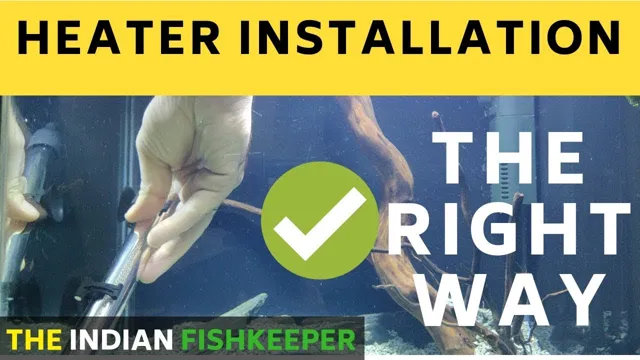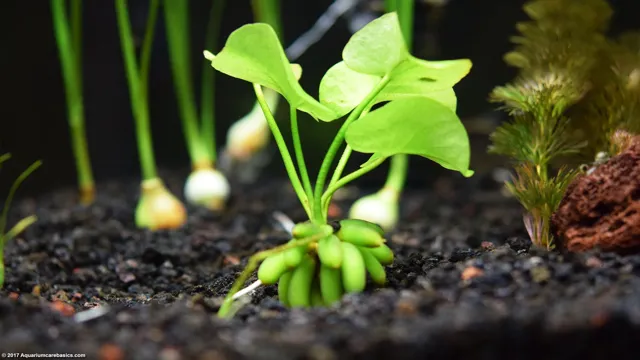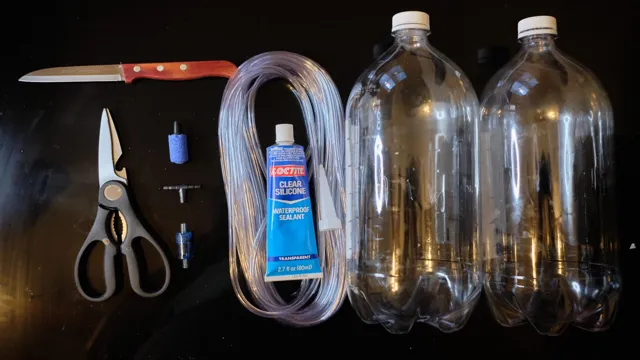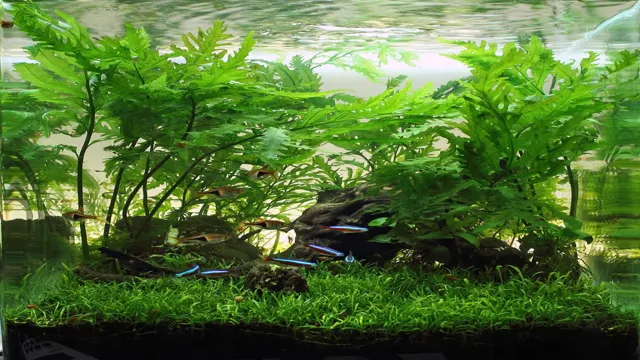Are you tired of buying expensive water heaters for your aquarium every time? Well, worry no more as here’s an ultimate guide on “How to Make a Water Heater for Your Aquarium” that will save you a lot of money and provide comfort to your aquatic pets. Maintaining the temperature of the aquarium is imperative for the well-being of your pet fish. A sudden change in water temperature can cause stress, illness, and sometimes even death.
A water heater is necessary to keep the aquarium water warm and stable, but buying one can be expensive. Fortunately, you can make a water heater for your aquarium with some basic materials. The DIY heater is easy to make and does not require any knowledge or technical skills.
Plus, it’s cost-effective and can be adjusted to suit the size of your aquarium. This guide will outline the materials needed, step by step instructions to make your DIY water heater, and tips to ensure the safety of your fish. Not only will this guide save you money, but it will also give you a sense of accomplishment and satisfaction in knowing that you’re capable of creating something yourself.
Get ready to impress yourself and your aquatic pets with your engineering skills by making your DIY water heater. Let’s dive in and learn how to make a water heater for your aquarium!
Introduction and Safety Tips
If you’re thinking about making a water heater for your aquarium, there are a few things you need to keep in mind to ensure both your safety and the well-being of your aquatic pets. First and foremost, it’s important to use high-quality components that are specifically designed for aquarium use, such as a specialized heating element. Additionally, be sure to use a thermostat to regulate the temperature and prevent overheating.
Always follow the manufacturer’s instructions closely, and avoid making modifications or alterations to the equipment. Lastly, be sure to regularly monitor the temperature of your aquarium water to ensure everything remains at a safe and appropriate level. By following these safety tips and being mindful throughout the process, you can successfully create a heater for your aquarium that will provide a comfortable and healthy environment for your fish and other aquatic creatures.
Why a Water Heater is Essential for Aquariums
Having a water heater is crucial for maintaining a healthy environment in your aquarium. The temperature of your water is a significant factor in the well-being of your aquatic pets, as many species are sensitive to fluctuations in temperature. A heater ensures that the water stays at a constant, comfortable temperature for your fish and plants.
However, safety is also a paramount concern when it comes to aquarium water heaters. Always make sure to choose the right size and wattage for your tank, and never leave a heater on when the water level is too low. Additionally, use a protective cover or guard to prevent accidental burns or electrical shock.
By following these safety tips and providing a stable, warm water environment, you can ensure the health and happiness of your aquatic pets.

Safety Tips to Consider for Your Aquarium Heater
Aquarium Heater Safety Tips Aquarium heaters are a crucial component of any healthy fish tank. These devices help to regulate water temperatures, creating a conducive environment for marine life. However, it’s important to practice safety when dealing with these gadgets to ensure the safety of your aquatic pets and yourself.
First, you should always unplug the heater before performing any maintenance, such as cleaning or adjusting it. Additionally, choose a heater with an automatic shut-off feature, which stops the device from overheating or failing. It’s also ideal to install a temperature controller sensor, which alerts you when the temperatures exceed a certain range.
To prevent shocks and electrocutions, make sure that the cord is intact and away from water. Lastly, position the heater in a secure location, where it won’t get knocked over by other aquarium equipment or curious fish. By taking these simple precautions, you can guarantee the safety of your aquarium heater and create a healthy and comfortable home for your pets.
Materials Needed for DIY Water Heater
If you’re looking for a way to keep your aquarium water warm, you can make a DIY water heater from easily available materials. The materials needed for this project include a plastic container, heating element, PVC pipes, wires, and a thermostat. The plastic container will be used to hold the water, while the heating element will help warm it up.
The PVC pipes will serve as the outlet and inlet for the water, and the wires will be used to connect the heating element to the thermostat. The thermostat is necessary to regulate the heat and keep the water temperature at a constant level. Once you have all the materials, you can assemble the water heater by cutting holes in the plastic container and attaching the heating element, thermostat, and PVC pipes.
With the DIY water heater, you can ensure that your aquarium water stays warm and your fish remain comfortable and healthy. (See Also: How to Layer Different Aquarium Substrate for Optimum Fish Health and Tank Aesthetics)
Things You Need to Purchase for Making a Water Heater
Making your own water heater can be a cost-effective and sustainable option. To get started, you’ll need a few materials. One essential item you’ll need is a tank to hold the water.
You can use a metal or plastic drum that’s at least 30 gallons in size, or a 8-10 gallon stock pot if you’re making a small-scale heater. Next, you’ll need a heat source. This could be a propane burner, wood stove, or even a simple campfire if you’re heating the water outdoors.
You’ll also need copper tubing to create the heat exchanger, as well as fittings to connect the tubing to the tank and heat source. In addition, you’ll need insulation to keep the heat in, such as fiberglass or mineral wool. Finally, you’ll need a thermometer and pressure relief valve to ensure the system operates safely.
With these materials, you’re on your way to a DIY water heater that can provide hot water for all your needs.
Right Size of the Heater for Your Aquarium
When it comes to heating your aquarium, choosing the right size of heater is essential. If the heater is too small, it won’t provide enough heat to maintain the appropriate temperature, while a heater that’s too big can overheat the water and harm your aquatic pets. If you’re on a tight budget and would like to try DIY, here are some materials you’ll need to create your do-it-yourself water heater.
The first thing you’ll need is a waterproof container, such as a mason jar or a PVC pipe. You’ll also need a heat source, which can be provided by a light bulb or a heating coil. Other items that you might need include a thermostat, a thermometer, and some electrical wires.
Keep in mind that building your own water heater carries some risks, such as electrocution and improper heating, so make sure to follow instructions carefully and conduct proper research before trying it yourself.
Types of Thermometer and Sensor for Water Temperature
If you’re looking to DIY your own water heater, there are a few materials you’ll need before getting started. First and foremost, you’ll need a tank to hold your water. The size of the tank will depend on how much hot water you need, so make sure to do your research and choose the appropriate size for your household.
You’ll also need a heating element, like an immersion heater, to heat up the water in the tank. To control the temperature of the water, you’ll need a thermostat that can be set to your desired temperature. It’s important to use a reliable thermometer or sensor to ensure accurate temperature readings.
There are various types of thermometers available, including digital, analog, infrared, and mercury. Additionally, you can use a flow sensor to help maintain a steady flow of hot water. By having all these materials ready to go, you’ll be able to create your very own water heater and enjoy a continuous flow of hot water at your desired temperature.
Steps in Making a Water Heater for Aquarium
Are you looking for a cost-effective way to keep your aquarium water warm and comfortable for your fish? If so, making a water heater for your aquarium is a great DIY project to consider. Here’s how to make a water heater for aquarium: First, you’ll need a few materials, including a glass tube, heating wire, a power cord, and a thermostat. Start by wrapping the heating wire around the glass tube and securing it with electrical tape.
Then, connect the power cord to the heating wire and the thermostat. Once you’ve assembled the heater, submerge it in your aquarium, ensuring that it’s fully submerged and securely mounted to prevent damage or injuries to your pets. By creating your water heater for aquarium, you’ll have full control over its size, shape, and strength, making it the perfect solution for your specific aquarium needs.
With this simple yet effective DIY project, you can save some money on store-bought water heaters while providing a comfortable environment for your aquatic pets year-round. Give it a try today and enjoy happy, healthy pets and a beautiful aquarium display!
Step 1: Prepare and Build the Heating Element
Making a water heater for an aquarium is an important step in maintaining the health and comfort of your aquatic pets. The first step in this process is to prepare and build the heating element. This involves selecting the appropriate heating element for your tank size and type of fish, as well as ensuring it is compatible with the current setup of your aquarium. (See Also: How to Read Aquarium Thermometer: Your Complete Guide to Accurate Temperature Monitoring)
Once you have selected the heating element, you can begin the process of installing it. This may involve drilling holes in the tank or attaching it to the side with suction cups. It is important to follow the manufacturer’s instructions carefully to ensure the heating element is installed correctly and will function properly.
Neglecting this step can lead to inaccurate temperature readings and potentially harm your fish. By properly preparing and building your heating element, you can kick off your aquarium water heater project in the right direction and establish a comfortable and safe home for your aquatic life.
Step 2: Install and Assemble the Temperature Sensor and Control
Now that you have gathered all the necessary materials, it’s time to move on to the next step – installing and assembling the temperature sensor and control. This is crucial to ensure that your water heater for aquarium is working properly and maintaining a consistent temperature for your fish and aquatic plants. Begin by selecting a suitable location for the temperature sensor, such as near the heating element or towards the base of the tank.
Next, attach the sensor to the control unit, ensuring a secure connection. You can then mount the control unit using the provided clips or double-sided tape. Finally, plug in your water heater and turn on both the heater and the temperature control.
It’s important to keep a close eye on the temperature and adjust the control as needed to maintain a safe and stable environment for your aquatic pets. With the temperature sensor and control in place, you can rest easy knowing that your aquarium is well taken care of.
Step 3: Connect the Heating Element and Control Components
Now that you have constructed the main structure of your aquarium water heater, it’s time to install the heating element and control components. Choose a high-quality heating element that can maintain a consistent temperature for your aquarium. Mount it to the solid surface of the heater using screws or a clamp.
Then, wire the heating element to the control components, including a thermostat or rheostat, and an on/off switch. These components will allow you to adjust and monitor the temperature of your aquarium water. Make sure to follow safety guidelines and use the appropriate wiring and tools when installing these components.
A properly functioning water heater is essential for maintaining the health and well-being of your aquatic pets, so take your time and double-check everything before plugging it in. With these simple steps, you can create a custom and cost-effective water heater for your aquarium.
Important Reminders and Maintenance Tips for Your DIY Heater
If you’re looking to create a water heater for your aquarium, there are a few important reminders and maintenance tips you should keep in mind. First and foremost, safety should always be your top priority when working with electrical appliances. Before starting any DIY project, make sure you have the proper tools and equipment and that you know how to use them safely.
When it comes to maintaining your heater, regular cleaning is essential to prevent buildup and prolong its lifespan. Additionally, it’s important to check the temperature regularly to ensure it’s set correctly and not causing any harm to your aquatic pets. And if you ever notice any signs of damage or malfunction, be sure to address them promptly to prevent any accidents or further damage.
By following these tips and staying vigilant, you can easily create and maintain a safe and effective DIY heater for your aquarium.
Important Tips to Remember About Using Your Homemade Water Heater
When it comes to heating your home’s water supply, DIY options can be both cost-effective and rewarding. However, it’s important to keep in mind some key reminders and maintenance tips to make sure your homemade water heater stays in good working order. Firstly, make sure your unit is installed in a well-ventilated area with proper drainage to prevent any harmful gases from accumulating.
Secondly, regular cleaning and replacement of filters is important to ensure your heater works efficiently and safely. Additionally, inspecting the intake and exhaust pipes for any damage or blockages can also prevent potential malfunctions. Lastly, it’s always a good idea to have a professional inspect your homemade water heater to ensure it meets safety standards and is functioning correctly.
By following these important reminders, you can enjoy the benefits of a DIY water heater without any worries of potential problems down the line. (See Also: How to Lower Nitrates in Tropical Aquarium: A Complete Guide)
Regular Maintenance for Your Water Heater
Regular maintenance of your water heater is critical to ensuring that it runs smoothly and lasts for years to come. There are several things you can do to keep your DIY heater in top condition. A good place to start is by checking the pressure relief valve and draining any standing water to prevent corrosion and sediment buildup.
It’s also important to change your water filter regularly and inspect the burner assembly for any signs of wear or damage. If you notice any leaks or strange noises, it’s best to contact a professional plumber to assess the situation. Remember that neglecting regular maintenance can lead to expensive repairs or even replacement of your unit, so don’t delay.
Keep your heater running smoothly by giving it the care and attention it deserves.
Conclusion and Final Thoughts
With a little creativity and some basic materials, anyone can make a DIY water heater for their aquarium. Whether you’re looking to save some money or just enjoy the satisfaction of a self-made project, building your own water heater is a fun and rewarding experience. As long as you follow the steps carefully and take all the necessary precautions, your fish will be swimming in warm, happy waters in no time!”
FAQs
What materials do I need to make a water heater for aquarium?
You will need a heating element, a thermostat, electrical wiring, and a container to hold the heater.
How much wattage should I choose for my aquarium water heater?
The wattage you choose for your aquarium water heater depends on the size of your aquarium. As a general rule, you should choose a wattage of 5 watts per gallon of water.
Can I use a regular household heater for my aquarium water?
No, regular household heaters are not safe for use in aquariums. They are not designed to work in water, and can electrocute fish or cause fires.
How do I install a water heater for my aquarium?
First, turn off all power to your aquarium. Then, follow the manufacturer’s instructions for installing the heating element and thermostat. Once the heater is installed, fill your aquarium with water and let it run for at least 24 hours before adding any fish.
How do I maintain my aquarium water heater?
You should clean your aquarium water heater regularly to prevent buildup and ensure it is working properly. Follow the manufacturer’s instructions for cleaning, and never use abrasive cleaners or submerge the heater in water.
What temperature should my aquarium water be?
The temperature of your aquarium water depends on the type of fish you have. Some fish prefer warmer water, while others prefer cooler temperatures. Research the specific needs of your fish, and adjust your heater accordingly.
How long should I run my aquarium water heater?
You should run your aquarium water heater continuously to maintain a consistent temperature. Some heaters have a built-in thermostat that will turn off the heater once the water reaches the desired temperature.







